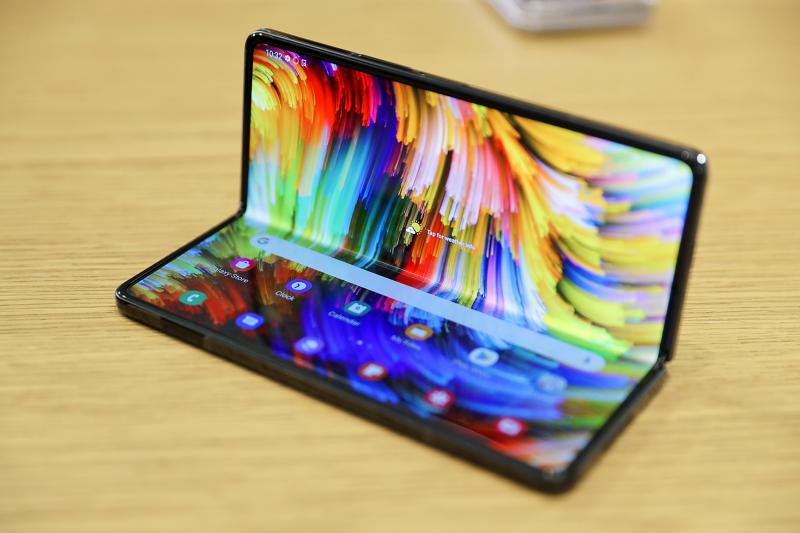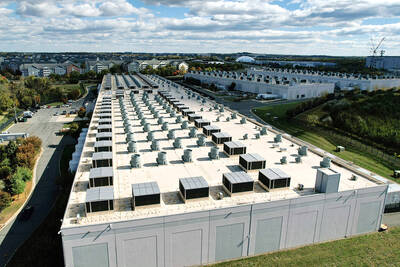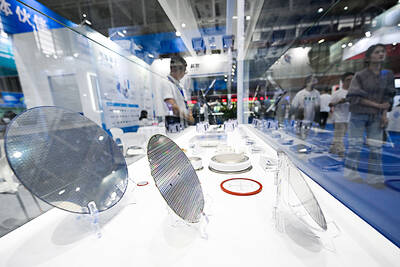Samsung Electronics Co’s operating profit rose more than 25 percent thanks to rising prices for semiconductors and surprisingly strong demand for its pricey foldable smartphones.
South Korea’s largest company reported operating profit of 15.8 trillion won (US$13.2 billion) in the three months ended last month, in line with the 15.75 trillion won average of analyst estimates. Sales were 73 trillion won, compared with estimates of 73.5 trillion, according to preliminary results released yesterday.
The world’s largest maker of memory chips and smartphones has benefited from strong demand as the global economy recovers from the COVID-19 pandemic. Chronic shortages have pushed up prices of memory chips, used in everything from mobile phones to smart cars, and the data centers powering cloud computing and services. Samsung is also expanding its foundry business, churning out custom chips for customers like Nvidia Corp.

Photo: AP
In the mobile business, Samsung is ramping up production to meet strong demand for its foldable phones. The Z series, launched in August, can cost more than US$1,800 but also includes the first sub-US$1,000 foldable in the Galaxy Z Flip 3, which has expanded the category’s customer base.
Samsung sold one million new foldable phones at home in Korea at the third-fastest sales pace after its Note 10 and Galaxy S8, the company said.
While Samsung is better known outside of South Korea for its smartphones, its profits are largely driven by its memory-chip business. Semiconductors account for the largest slice of its income.
Memory chip prices are expected to fall in the current quarter because of stockpiling by customers, signaling a potential cyclical downturn. Micron Technology Inc, one of Samsung’s primary rivals, gave a conservative outlook because PC demand is slowing.
“DRAM operating profit could climb due to sequential bit growth of 3-5 percent and also price rises in 3Q. NAND may also drive strong profit growth in 3Q due to a 10-15 percent sequential rise in bit shipments with a price increase of 5-9 percent. The chip shortage may help operating profit for the foundry business climb in 3Q. New foldable smartphones may fuel sales growth in the mobile division,” Bloomberg Intelligence said.
“While we expect DRAM market weakness in 4Q in 2021 and 1Q in 2022 on weak PC demand and relatively high inventory level at clients, we believe memory makers are more likely to accumulate inventory and revise down their 2022 capex to support memory pricing, rather than maximizing production,” Citigroup analyst Peter Lee said. “In any case, we expect the DRAM market to recover in 2022 due to supply constraint, given limited available clean room space and the launch of DDR5 products.”
Samsung’s foundry business has benefited from the transition to 5G wireless technology and high-performance computing, which have increased the global need for more sophisticated chips.
Robust sales of the Z foldable phones are likely to continue into the first quarter, and Chinese smartphone brands are increasing their purchases of foldable displays from Samsung, said Greg Roh, a senior vice president at HMC Securities.

Taiwan’s exports soared 56 percent year-on-year to an all-time high of US$64.05 billion last month, propelled by surging global demand for artificial intelligence (AI), high-performance computing and cloud service infrastructure, the Ministry of Finance said yesterday. Department of Statistics Director-General Beatrice Tsai (蔡美娜) called the figure an unexpected upside surprise, citing a wave of technology orders from overseas customers alongside the usual year-end shopping season for technology products. Growth is likely to remain strong this month, she said, projecting a 40 percent to 45 percent expansion on an annual basis. The outperformance could prompt the Directorate-General of Budget, Accounting and

The demise of the coal industry left the US’ Appalachian region in tatters, with lost jobs, spoiled water and countless kilometers of abandoned underground mines. Now entrepreneurs are eyeing the rural region with ambitious visions to rebuild its economy by converting old mines into solar power systems and data centers that could help fuel the increasing power demands of the artificial intelligence (AI) boom. One such project is underway by a non-profit team calling itself Energy DELTA (Discovery, Education, Learning and Technology Accelerator) Lab, which is looking to develop energy sources on about 26,305 hectares of old coal land in

Netflix on Friday faced fierce criticism over its blockbuster deal to acquire Warner Bros Discovery. The streaming giant is already viewed as a pariah in some Hollywood circles, largely due to its reluctance to release content in theaters and its disruption of traditional industry practices. As Netflix emerged as the likely winning bidder for Warner Bros — the studio behind Casablanca, the Harry Potter movies and Friends — Hollywood’s elite launched an aggressive campaign against the acquisition. Titanic director James Cameron called the buyout a “disaster,” while a group of prominent producers are lobbying US Congress to oppose the deal,

Two Chinese chipmakers are attracting strong retail investor demand, buoyed by industry peer Moore Threads Technology Co’s (摩爾線程) stellar debut. The retail portion of MetaX Integrated Circuits (Shanghai) Co’s (上海沐曦) upcoming initial public offering (IPO) was 2,986 times oversubscribed on Friday, according to a filing. Meanwhile, Beijing Onmicro Electronics Co (北京昂瑞微), which makes radio frequency chips, was 2,899 times oversubscribed on Friday, its filing showed. The bids coincided with Moore Threads’ trading debut, which surged 425 percent on Friday after raising 8 billion yuan (US$1.13 billion) on bets that the company could emerge as a viable local competitor to Nvidia